Making Fermented Pickles
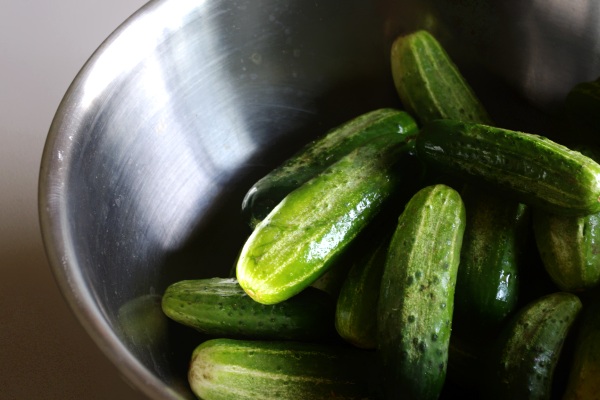
A few people have asked me exactly how I make my lacto-fermented pickles. I haven’t really shared a recipe because I don’t actually use one. I use a method instead.
You see, when I first started making ferments I was totally obsessed with exact recipes. I was still in the pasteurized mentality and the thought of leaving things out at room temperature to actually improve the health of the food went against everything I had ever been taught.
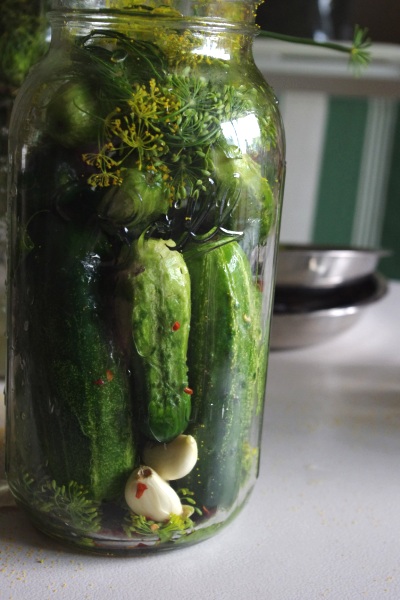
But as I’ve experimented more over the last five years I have learned that no two ferments are alike, which is part of the beauty of it, and that as long as you understand the method you can ferment just about anything.
We have really come to enjoy these pickles and the help that they are to our digestion.
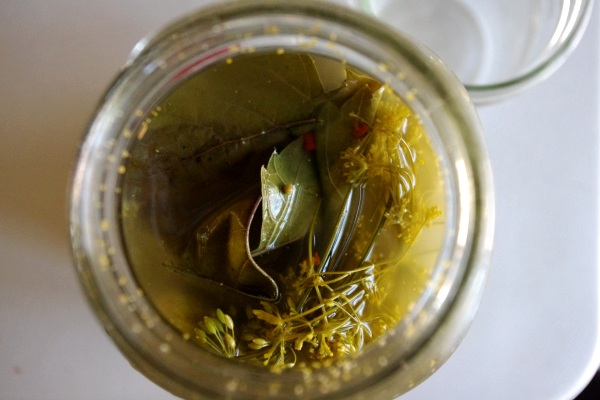
Here is my method:
Make a brine from 5 tablespoons of fine-grained sea salt and two quarts of hot water. Allow to cool before using.
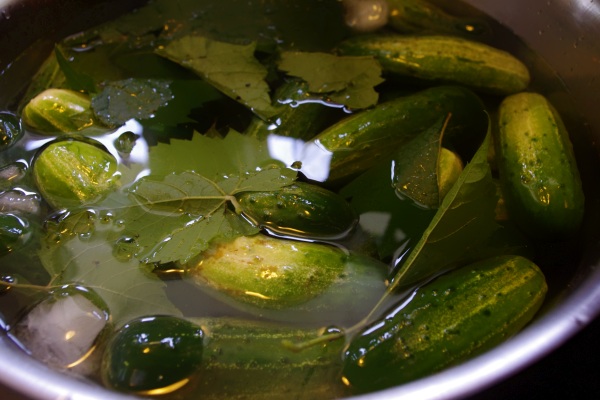
Meanwhile wash your cucumbers and grape leaves really well and allow to soak in some cold water.
At the bottom of a 1/2 gallon jar add a generous amount of dill, two grape leaves, a few cloves of peeled garlic, and a sprinkle of red pepper flakes.
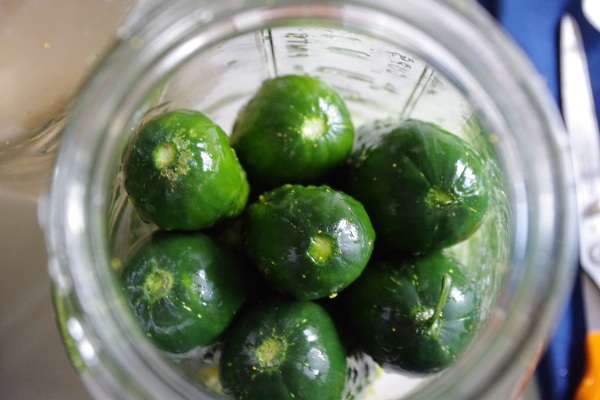
Start packing the largest cucumbers vertically in the bottom half of the jar so that they fit tightly. Add another layer of dill, grape leaves, garlic, and spices.
Layer in the smaller cucumbers horizontally or vertically, however you can best pack them in tight, leaving a good 1 1/2 – 2 inches of head space. Add one more layer of dill and red pepper flakes.
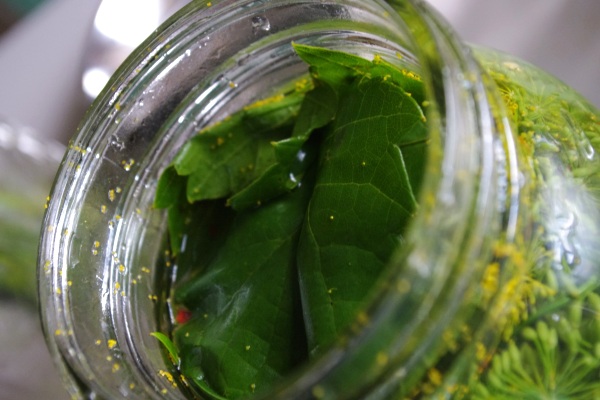
Pour the brine over the cucumbers until completely covered. Place a grape leaf over top of the cucumbers and dill so that it keeps them under the brine level. Make sure there is at least an inch between the brine and the top of the jar.
Place the jar lid on tightly and leave at room temperature for 3-5 days, depending on the temperature. When it is really warm (80+) I find that three days is enough. If it is cooler I like to leave them for another day or two, or until the brine is bubbly and cloudy.
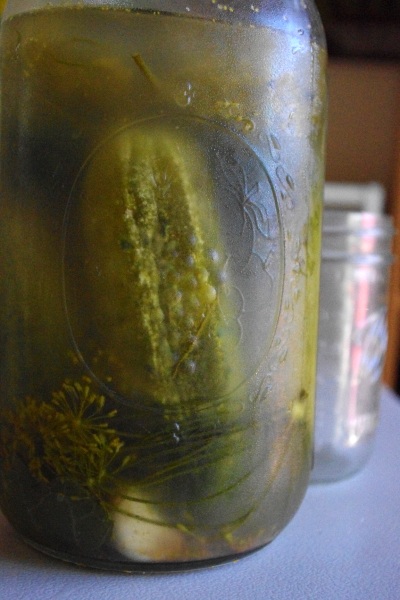
During this time I also like to "burp" the jars every day to release some of the pressure. We have had a jar crack and explode on us in the middle of the night and had to throw away the pickles.
Place in the refrigerator or other cold storage facility. Eat them right away or leave them to age which will produce an even better flavor and you can enjoy them in the dead of winter.
So that’s how I’ve been making our pickles.
Do you have a different method you can share?

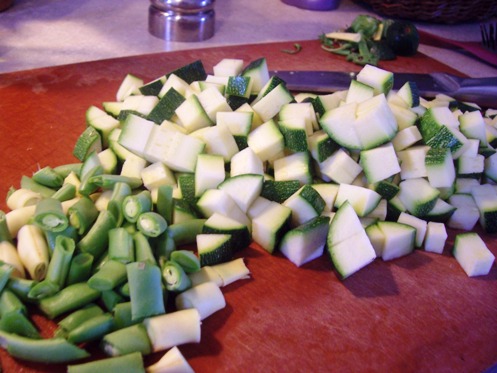
Yummy! Im going to try these this weekend. I’ve been trying to get a good recipe for pickles, thanks!
I tried, for the first time, with a recipe from the Joys of Pickling cookbook I believe it was. This recipe is similar, but it had you leave the pickels out for 2 weeks and no lid. (I did lay a dishtowl over top just to keep out dust and tiny bugs etc.
They smelled so good at first, but disappointly, at the two week mark, I pulled a pickle out and it was a heaping mush 🙁 I was so disappointed. I am not sure what I did wrong.
Allison – Did you use any grape, oak, or horseradish leaves? The addition of these leaves is crucial to the crunch of the pickle. No matter what else I have done the pickles are simply not crunchy without them.
I made some fermented pickles earlier this summer from a different recipe. They stayed crisp, but they were way, way too salty for us. I have a bunch of cucumbers laying around now, so I’ll try this method. It doesn’t seem nearly as salty as the other recipe and I like the addition of pepper flakes.
Sarah, I made them once from the NT recipe that recommended adding extra sea salt in place of the whey and it was way too salty for us as well.
This seems like a good way to ease into a fermenting lifestyle—THANK YOU!
I was just asking about fermenting pickles today! My first batch came out mushy too, but I cut them into rounds. I guess leaving them whole helps. Also, does it matter what kind of oak tree? I have a Live Oak in my front yard….
Thank you for your post a while back with 6 tips on troubleshooting for pickles! I just used your list a couple of days and another recipe to attempt pickles again! My 3 year old son and I went on a hunt around the property we live on for an oak tree. We found 3 :)! So the pickles are fermenting now with some spices and some oak leaves. The brine is getting cloudier.
I did not put a lid on it, though, but put a cup in it to keep the pickles down. Is it okay if they are not fully covered?
Shannon: I did not use Grape/Oak or Horseradish leaves :/ I will have to try again. I have grape vines in my backyard…can I just pick the leaves right from there?
Scratch that last comment/question! I just started reading through your Fermenting for Beginners posts and see you did, in fact, pull wild grape leaves from your yard 😉
Sorry for the add’l comments. I keep trying to hit reply from my orignial and my computer is protesting!
Shannon – Is the jar size crucial to the recipe? I would love to try these, but only have quart jars on hand.
Kate – Nope, I’ve used quarts before. Because of the size difference I like to use very small cucumbers with the quart jars, though.
Are the red pepper flakes necessary? I usually find pickles too spicy.
I’m curious why you don’t use whey in this recipe.
Thanks!
A free tip. 🙂 If you are trying different methods and have as poor a memory as I do, write down how you made each batch! I finally made a batch my husband and most of the kids liked and I can’t remember how it was different from the others. sigh.
I really want to ferment some pickles, well, I guess it’s fermenting the cucumbers to have pickles, anyway. I planted some cucumbers hoping to make pickles but unfortunately I’ve only been able to harvest 2 only one of which ended up being edible. So all that to say I guess I’ll have to get some cucumbers at the farmers market but where can I find grape leaves? I don’t think I even know anyone who has a grape arbor.
Could I try this recipe with slices or spears?
I made my first fermented cucumbers a while ago and they turned out great! The recipe I used called for a little too much salt for my taste but I’m really happy with the results. I think I would like your recipe lots better. Thanks for posting on it. So, have you ever made fermented dilly beans? I would think they would work well too!
How do you store them if you don’t have cold storage? For that matter, by cold storage, do you mean a basement or root cellar? I have neither, and no possibility of either.
I;m wondering if I can make them with spears too — my cucumber is big. Also I was going to try without the oak leaves– seems like not worth it?
Two questions-
1) why sea salt? I use real salt, would that work?
2) I thought you couldn’t preserve garlic without first acidifying it. Is that incorrect?
3) can you use that brine to experiment with fermenting other things? I have made lacto-fermented dilly carrots and really liked them and want to lacto ferment more things.
4) I’ve made one batch of Lacto-fermented pickles and really enjoyed them. I was confused though because I left both ends on and didn’t add grape leaves but they were crunchy. Did they not ferment enough and that’s why they were crunchy? They tasted pickle-y.
* 4 questions
Great writeup!
I have a question about “burping” the jars.
I just made a batch of fermented pickles, letting them ferment at around 70F for 4 days and when I sampled one, the taste was just right. My understanding was that the pickles could then be refrigerated, which would slow the fermentation process considerably. I should add that I used the glass Fido jars with wire bail-type closures.
Prior to placing the jars into the fridge, I put the rubber gaskets on the lids and closed them to form a seal. When I opened one of the jars today, some of the brine came spurting out, telling me that the fermentation had not slowed down very much. I don’t want this to keep happening, so I was wondering how I can store the jars in the fridge without the risk of having a jar break due to the pressure build up.
Any advice would be appreciated!
I made my first batch a couple of weeks ago with your first post and another recipe. They were very salty so I stuck them in the fridge to try later. When I took them out yesterday there was a little mold on top. Are they o.k. to eat? I have a second batch sitting on my counter now, using this post. We’ll see what happens. Thanks.
Heather – You should be able to scrape the mold off and still eat them. I have never had them go moldy, but I do find they mellow after a couple of weeks in the fridge.
I just cracked open my first jar this morning and they are great, very crunchy, very garlicky. I think I’d prefer them a bit more scour so I might I’ve them another day or so fermenting but I’m very pleased! I added some whey and ised a little less salt.
Are there special cucumbers that you need to use? In a 1/2 gallon jar I can’t imagine fitting more than 3 cucumbers in (width-wise) and I doubt they would fit in height-wise. Do we just have huge cuccumbers where I’m from? Thanks.
Kristy – Pickling cucumbers are ideal as they are only 2-3 inches long and small enough to cram a bunch in a small space like a 1/2 gallon jar. Otherwise, you could use large cucumbers and cut into spears.
How long does it take a comment to be approved?
I would like to make some as i am trying to bring healthier foods into the house by knowing what we r putting into them. If these are not the water bath way of canning kind what is the shelf life on them? Do they freeze well? or need to stay refrigerated? Thank
I made some fermented pickles, but they seem to have a odd after taste to them.
I know that they will not hurt to eat them, because I have, but what do think I did wrong.
This is a winner of a recipe for someone who doesn’t really have a recipe! Thank you! It neared 100 degrees the last two days, it took 24 hours to ferment my cukes and WOW are they awesome. I get the whole ‘champagne’ thing now with the fizzing upon completion. Thank you again for sharing this!
Hello!
I made the pickles and they were crunchy!!!! Yea!!!! I made some before and they were soggy. Oak leaves worked great. My question is though….we like them spicey….could I add some fresh jalapeno peppers to the mix? Won’t they just ferment, too?
Thanks!
Kellye – Absolutely! and yes they will ferment, but they will add flavor and you can eat them too.
Also…one more thing…I left my pickles on the counter for a couple of days and it bubbled and turned a little cloudy. If you wanted them to taste more garlicy or have a stronger taste from whatever you put in the jar with them…do you leave them on the counter longer? They tasted ok…but kinda bland for my husband. He likes really spicey stuff. 🙂
Thanks!
Kellye – The flavors will continue to meld even in cold storage. If you would like to ferment them longer you’ll have to find a cooler spot (say 65 degrees or so).
To help with the pressure. Cam you not just put a coffee filter and rubber band over the top, like you do to make Kombacha Tea?
Just wondering how these are lacto-fermented without the addition of whey. I’ve made pickles for some time with a slightly different recipe (it also uses vinegar, maybe that messes with the fermentation?), and I’ve never had a fermented type reaction. Maybe I just didn’t wait long enough before refrigerating….
Can I make the feremented pickles in a crock instead of indivual jars?
I did the same the same thing and I didn’t use the fine sea salt, but the chunky huge kind. Woops. Wondering if its too late to try to save the pickles I made?
I made a batch of pickles but they were sooo salty they were inedible. I used a quart jar instead of a 1/2 gallon container. They were also quite soft although I used oak leaves. I let them ferment for at least 7 days because the weather has been somewhat mild and I was out of town. I’d try again, but do you have any suggestions?
Colleen – When you used the quart jar did you also halve the salt? Seven days was probably too long to ferment them. Even if your room temperature is 65-70 I would only do 3-4 days. Basically if they’re bubbly and the brine is cloudy I would move them to cold storage.
So maybe try again, use half the salt for a quart jar, and only ferment for a few days.
http://www.thehealthyhomeeconomist.com/video-how-to-pickle-cucumbers/
Not sure if the above link will be appreciated – but she explains why it is important to cut off the blossom end of the pickle so they stay crisp – something about enzymes.
I was wondering if you or anyone has ever used dill weed instead of fresh dill? I live out in the country and can’t find fresh dill.
Thanks!
I followed your method except I sliced my cukes into sandwich slices and they turned out fantastic! I had to skip the grape/oak leaves and they were still crunchy. at least for now?? also I added dill seed from last year’s garden because I couldn’t get any fresh, flavorful dill yet. They are delightfully dilly 🙂
Will this method work safely and taste good with other veggies like zucchini and carrots? Thanks!!!!!
Angela – Yes! We love fermented carrots and zucchini. I have recipes for both in my upcoming book Traditionally Fermented Foods (Page Street Publishing, May 2017). I’m so glad you are enjoying them!
Very good blog! Do you have any helpful hints for aspiring
writers? I’m planning to start my own blog soon but I’m a little lost on everything.
Would you advise starting with a free platform like WordPress or go for a paid option?
There are so many choices out there that I’m totally confused .. Any recommendations? Bless you!
I just finished my first batch of pickled jelly beans. They taste *fantastic*! Next I’m going to try these cucumbers. What are people’s favorite varieties of cukes to pickle? Also, does size matter?
I just started a quart with garlic, bell pepper, okra, and various peppers fresh from the garden. I’m trying to make a new brine — I did not use any salt. Only whey and old brine. Do y’all think that the counter time should still be 3-5 days? Another question– Weston Price says to not burp bc it’s an anaerobic process. ??? Thoughts?
Jill – The old brine may not contain enough salt since it probably was absorbed somewhat into the old vegetables. I’d be interested to see how it goes.
If you are using mason jars with tight-fitting lids you can barely burp the jar, just enough to release a tiny bit of gas, once or twice a day. If you don’t burp these types of containers at all, they will explode. Ask me how I know. 🙂
(P.s. I emulated a Ukrainian woman’s style). Never done it before. Don’t want to die of botcholism.
so delish! I just made a first batch of pickles by chance because I had some cukes that were about to go bad and decided to give it a try. They were the bigger cucumbers and it turned out fine. What % of brine is that measurement? I believe we used a 5% brine since we didn’t use a pickl-it, fermented for 5 weeks in cold storage and it tastes great. Love how fermenting is not precise measurements as long as the good microbes have the right conditions.
How long will these pickles last in cold storage. I’m accustomed to processing in a water bath. Can that be done or will it ruin the recipe? I’m trying to move into ferments. Thanks!
The most important step is to pick your cucumbers at night or early morning and ferment the same day. You don’t want to use warm veggies when fermenting.. That along with bay leaves, grape leaves or oak will insure a crunchy pickle. My grandmother who passed away at 98 used the same method and taught us to do the same. Perfect every time.